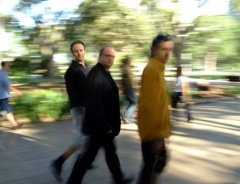
Popular trio The Necks have completed an extensive tour of the United States and Canada, garnering arguably more mainstream media attention than any other Australian ensemble in recent years.
The group, already a drawcard in Australia and Europe, performed in a number of North American centres, including New York, Boston, Chicago, Knoxville, Pittsburgh, Los Angeles, San Francisco and Vancouver.
Ashley Capps, organizer of the Big Ears music festival in Knoxville Tennessee, was interviewed in advance of the event by the Atlanta Journal-Constitution and told the paper that The Necks were “one of my favorite groups of all time”.
Read articles and reviews from the tour:
Preview – Los Angeles Times
Preview – The New Yorker
Preview – Atlanta Journal-Constitution
Preview – Straight.com (Vancouver)
Preview – Vancouver Sun
Preview – Buzzine
Preview – Pittsburgh City Paper
Review – Pittsburgh Tribune-Review
Review – The New York Times
Review – All I Know
Review – Buzzine
Review – Pitchfork
Review – John Litweiler (below)
Chicago Cultural Center
Chicago, IL
Tuesday, February 3, 2009
Tuesday night in Chicago was bitterly cold, nearly zero degrees Fahrenheit, with ice and several inches of snow covering the city and brutal winds blasting from the north. But Chicago jazz and new music people love to hear a free concert, so the little theater at the downtown Cultural Center was crowded with a couple hundred listeners. Actually, this concert was well publicized, even though The Necks were new to America, on their first tour.
They played two sets on Tuesday, a total of nearly two hours of music. If you haven’t heard The Necks, what they do is improvise on one chord. What they improvise is simple licks that they vamp over and over, licks that ever so slowly and slightly alter, move, transmogrify. There is no melody line over the trio’s vamping, no main line of development. The net effect is of very long introductions to events that never happen.
Lazy reviewers such as myself love to write about an act like The Necks because their music is easy to describe and they start from a concept that might even be taken, or mistaken, as an important development. For example, perhaps the best way to show what The Necks’ music is like is to give a blow-by-blow account. The first set began like this:
7:10 p.m. Piano plays a little noodling lick centered on a repeated treble note, then rests; Abrahams then repeats this little motif over and over, with a little rest between each repeat.
7:11 Bass enters with intermittent, frantic strums on one note.
7:12 Drums enter with quiet, repeated mallet sounds on toms, snares. Now they are a trio, all repeating their little, complementary motifs.
7:18 Bass, by now, is strumming different repeated tones and the piano is repeating treble chords based on that opening motif.
7:21 Bass strums and mallets on drums are now making a very gradual crescendo, while the piano chords remain piano.
7:25 The piano piano chord becomes fuller and Abrahams is now repeating the chord without rests. There are no rests between the forte, machine-gun bass strums, which alternate without any more rests between two tones — a sorta seasick feeling.
7:29 Now the bass strums three alternate tones.
7:32 As the pounding of a piano chord (Abrahams has added some bass-clef notes, too) also begins to crescendo — remember, this trio crescendo is extremely gradual — cymbal rolls swell at the end of each series of three bass tones, and now the bass drum enters.
7:37 A drumsticks, now, pattern on snares; the bass now frantically bows two alternating tones. Is the piano playing very quiet treble notes or chords? Can’t tell because repeated bass notes, drum patterns, and hammered piano bass-clef chords are so loud.
7:38 Drum rolls now alternate with the drum pattern.
7:40 Bass introduces a longer, high, treble tone to alternate with the two frantically bowed tones.
———————————–
Chicago-based writer John Litweiler is the author of Ornette Coleman: A Harmolodic Life and The Freedom Principle: Jazz After 1958.
Read the full review on the SIMA website.
———————————–
Below The Necks’ bass player Lloyd Swanton responds to John Litweiler’s review.
I’m not sure how to take John Litweiler’s description of himself as a “lazy reviewer”. Perhaps it’s false modesty, utilised preemptively. Or perhaps he’s being totally honest, which we’d have to take as an admission that his review is the disrespectful, out-of-hand effort I suspect it is.
His bizarre decision to opt for a blow-by-blow description of our concert raises so many troubling issues I hardly know where to begin.
Above all else, such an act has a strong whiff of premeditation about it, as if he had already made up his mind to hate the concert before arriving.
But that’s only a suspicion of mine, and cannot be proven. Let’s give him due respect as a critic, and assume that, in a spirit of impeccable fairness, he decided, mere seconds into a concert, that the best way to convey to the reader what was taking place was to whip out his watch and maintain a detailed written log of every musical entry and departure. There are still many valid objections to this approach; to his claim of it being “perhaps the best way to show what The Necks’ music is like”:
It is ridiculous to think that anyone would be able to objectively assess any concert, if attempting simultaneously to log every single musical move. Our brains simply aren’t wired that way. Either the logging, or the objectivity, is going to suffer.
Read the full response on the SIMA website.
Find out more about The Necks.













